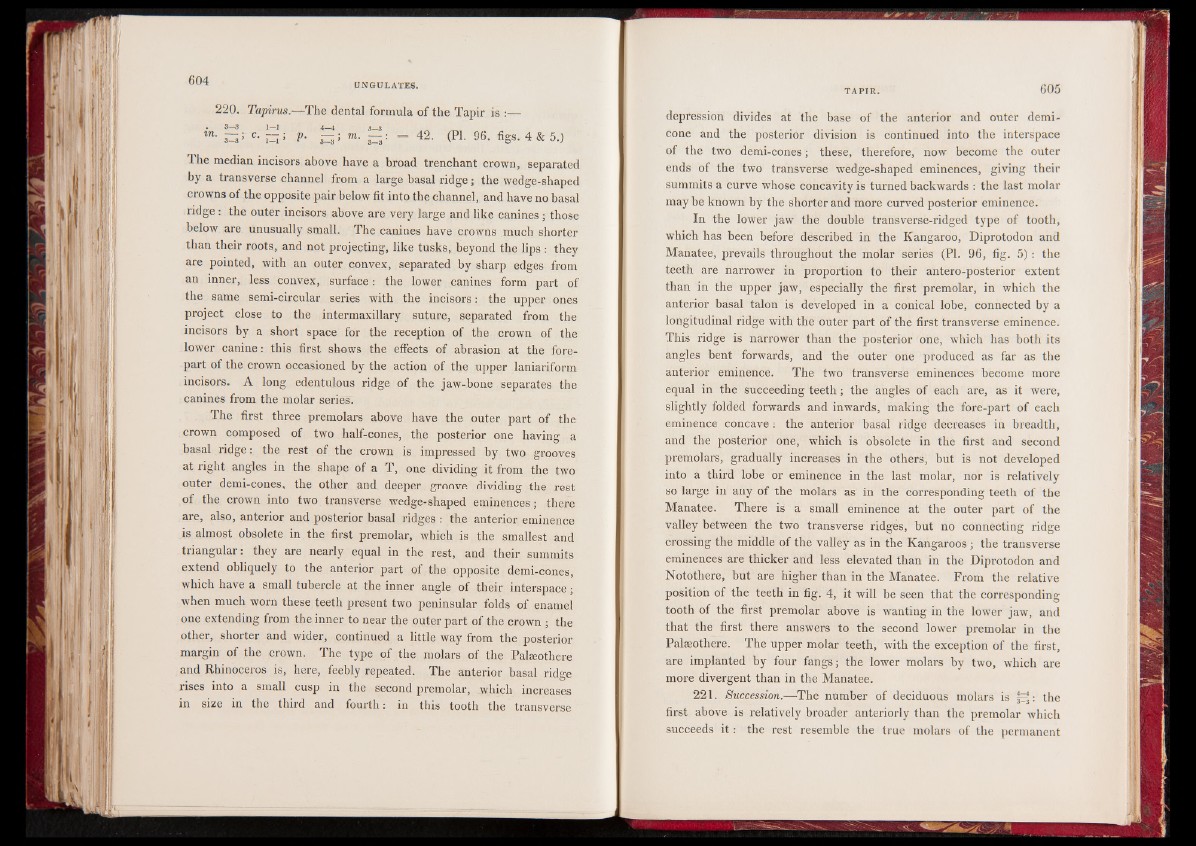
220. Tapirus.
3—8 1—1
—The dental formula of the Tapir is :—
V • H ’ m - ““ 4 2 - (P1- 9Ö- figs. 4 & 5.J
The median incisors above have a broad trenchant crown, separated
by a transverse channel from a large basal ridge; the wedge-shaped
crowns of the opposite pair below fit into the channel, and have no basal
ridge : the outer incisors above are very large and like canines ; those
below are unusually small. The canines have crowns much shorter
than their roots, and not projecting, like tusks, beyond the lips : they
are pointed, with an outer convex, separated by sharp edges from
an inner, less convex, surface: the lower canines form part of
the same semi-circular series with the incisors! the upper ones
project close to the intermaxillary suture, separated from the
incisors by a short space for the reception of the crown of the
lower canine: this first shows the effects of abrasion at the forepart
of the crown occasioned by the action of the upper laniariform
incisors. A long edentulous ridge of the jaw-bone separates the
canines from the molar series.
The first three premolars above have the outer part of the
crown composed of two half-cones, the posterior one having a
basal ridge: the rest of the crown is impressed by two grooves
at right angles in the shape of a T, one dividing it from the two
outer demi-cones, the other and deeper groove dividing the rest
of the crown into two transverse wedge-shaped eminences; there
are, also, anterior and posterior basal ridges : the anterior eminence
is almost obsolete in the first premolar, which is the smallest and
triangular: they are nearly equal in the rest, and their summits
extend obliquely to the anterior part of the opposite demi-cones,
which have a small tubercle at the inner angle of their interspace;
when much worn these teeth present two peninsular folds of enamel
one extending from the inner to near the outer part of the crown ; the
other, shorter and wider, continued a little way from the posterior
margin of the crown. The type of the molars of the Palmothere
and Rhinoceros is, here, feebly repeated. The anterior basal ridge
rises into a small cusp in the second premolar, which increases
in size in the third and fourth: in this tooth the transverse
depression divides at the base of the anterior and outer demi-
cone and the posterior division is continued into the interspace
of the two demi-cones; these, therefore, now become the outer
ends of the two transverse wedge-shaped eminences, giving their
summits a curve whose concavity is turned backwards : the last molar
may he known by the shorter and more curved posterior eminence.
In the lower jaw the double transverse-ridged type of tooth,
which has been before described in the Kangaroo, Diprotodon and
Manatee, prevails throughout the molar series (PL 96, fig. 5) : the
teeth are narrower in proportion to their antero-posterior extent
than in the upper jaw, especially the first premolar, in which the
anterior basal talon is developed in a conical lobe, connected by a
longitudinal ridge with the outer part of the first transverse eminence.
This ridge is narrower than the posterior one, which has both its
angles bent forwards, and the outer one produced as far as the
anterior eminence. The two transverse eminences become more
equal in the succeeding teeth; the angles of each are, as it were,
slightly folded forwards and inwards, making the fore-part of each
eminence concave : the anterior basal ridge decreases in breadth,
and the posterior one, which is obsolete in the first and second
premolars, gradually increases in the others, but is not developed
into a third lobe or eminence in the last molar, nor is relatively
so large in any of the molars as in the corresponding teeth of the
Manatee. There is a small eminence at the outer part of the
valley between the two transverse ridges, but no connecting ridge
crossing the middle of the valley as in the Kangaroos ; the transverse
eminences are thicker and less elevated than in the Diprotodon and
Notothere, but are higher than in the Manatee. From the relative
position of the teeth in fig. 4, it will be seen that the corresponding
tooth of the first premolar above is wanting in the lower jaw, and
that the first there answers to the second lower premolar in the
Palaeothere. The upper molar teeth, with the exception of the first,
are implanted by four fangs; the lower molars by two, which are
more divergent than in the Manatee.
221. Succession.—The number of deciduous molars is §Ef: the
first above is relatively broader anteriorly than the preinolar which
succeeds i t : the rest resemble the true molars of the permanent